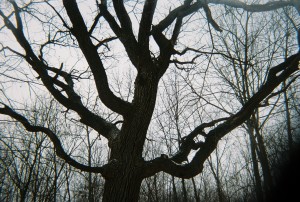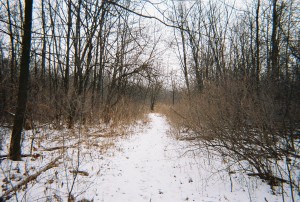The announcement that the Forest Preserve District of Will County has begun work on developing a short trail through Teale Woods, a small nature preserve near where I live in Joliet, Illinois, got me thinking about this little essay I wrote about that patch of urban nature for the Joliet Herald-News back in March of 2010.
The advent of spring last week inspired me to visit one of my favorite quiet corners of Joliet — a place where time slows down and wild nature flourishes amidst the paved-over, gritty landscape of concrete, traffic noise, and hustling people.
My destination was Teale Woods, a 15-acre woodland along Theodore and Center Streets on Joliet’s near northwest side. With only one low-profile sign marking its existence as Will County Forest Preserve property, Teale Woods is still undeveloped and without official public access; but a couple of informal trails cut through the woodland and afford a quiet route away from the tumult of Theodore Street’s traffic.
This humble urban sanctuary is emblematic of wild spaces that exist, and sometimes flourish, against all odds within the built landscape of our cities. Homes, businesses, and busy roads are only steps away. The thoughtless litter of humans, newly revealed from the recent melting of winter’s snow cover, distracts the eye and disturbs the spirit.
Nevertheless, these scrappy, imperfect woods provide a natural haven where one can hear the plaintive tones of a white-throated sparrow and study the rugged form of a downed oak.
I suspect very few people in Joliet today know this place’s namesake, Edwin Way Teale. Born in 1899 in Joliet, Teale’s love of and fascination with nature were stoked in his formative years during visits to his grandparents’ farm near the Indiana Dunes. He later became one of the most celebrated American nature writers and photographers of the 20th century.
One of Teale’s most admired books was North with the Spring (1951), which chronicles a 17,000-mile journey following and celebrating the season’s arrival throughout the eastern US. While Teale visits several famous landscapes along the way, he also describes many virtually unknown spots of no particular significance — except that they provided a place for him to encounter a lively insect, find a native wildflower, or admire an old tree.
I like to think that Teale Woods in Joliet — about as low-profile and neglected as a nature preserve can get — is been one of those places he would’ve cherished.
The next time I visit the woods, I’ll pause a moment to reflect on Edwin Way Teale’s immeasurable impact upon Americans’ growing interest in preserving wild nature, even in cities. Then, I’ll grab my work gloves and trash bag, and get down to work picking up some litter.
This essay was published as “Teale Woods Hidden Joliet Gem” on 25 March 2010 in the Joliet Herald-News, p20. A few month’s after the article’s appearance, the Will County Forest Preserve District held public hearings on planned future developments of Teale Woods. The WCFPD plans to start restoring the woodland in 2011.


One thought on “Teale Woods in Joliet: Urban Nature Restoration”
Comments are closed.